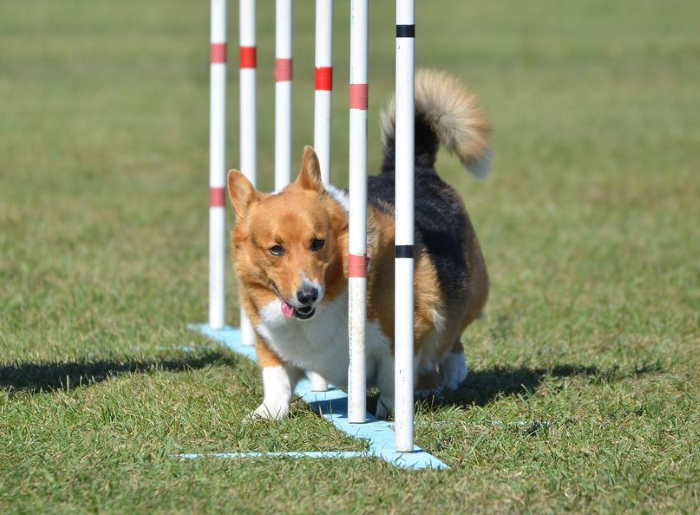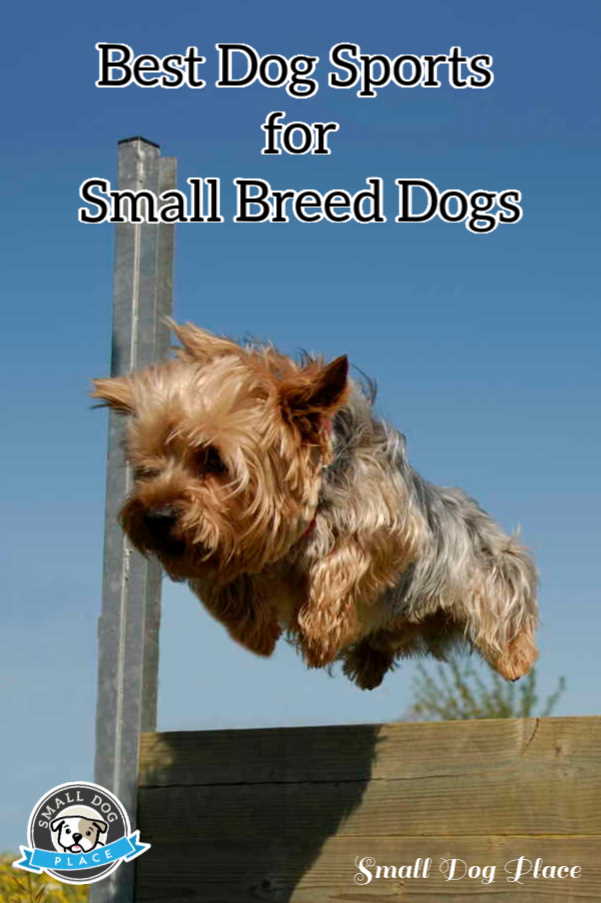Best Dog Sports for Small Breeds
Dog Sports by Danielle Muehlenberg |Published 05-06-2020
If you’ve got a small breed dog full of energy, you might wonder what sports you can engage in with your beloved companion.
While it‘s true that not all sports are suitable for small dogs as this might harm their joints or they simply don’t have the physical capability to do the job (Schutzhund as a sport comes to mind), there definitely are some.
Ever seen a giant breed completing an Agility course?
Here you can check one out. Not that graceful, huh?

In the following I will present you with the best dog sports for your small dog that won’t harm him but instead will gain you both a ton of fun and improve your bond.
7 of the Best Dog Sports for Small Breed Dogs
1. Agility: Dog Sports Made For Small Dogs
 Agility is one of the best dog sports for small breed dogs.
Agility is one of the best dog sports for small breed dogs.As pointed out above, agility is a sport for all breeds to engage in and although Mastiffs will be at a disadvantage and Collies will rise to the top, there’s still space for smaller breeds.
Actually, there are even categories designed specifically for smaller breeds. High-energy breeds like the Jack Russel do very well here.
It’s a great way to exercise your dog mentally while also providing an outlet for his physical needs to get out that excess energy.
There are various ways to build an agility course in your own backyard. Just get creative with the obstacles.
How to Ensure Your Dog’s Success
Start by slowly introducing your dog to basic obstacles and reserve the advanced stuff for later (hurdles, tunnels, weave poles, hula hoops, etc.).
The most important rule about any kind of activity with your dog is setting him up for success. You want your dog to succeed to avoid frustration and low levels of confidence. Once your dog has built a certain level of confidence, mastering every other obstacle will just be a matter of time.
Lure your dog with his favorite treat. This can be especially helpful if your dog refuses to go through a tunnel, for example. The dark and close walls can be really daunting so encouragement and positive reinforcement goes a long way.
Your dog might be a lot smarter than you think. While some dogs have a steep learning curve, others might take a while to figure things out. Be patient and persistent.
2. Herding Events
While the first breeds that comes to mind for this kind of event might be the various Shepherds, Collies, and Kelpies, there’s another great herding breed out there: Corgis.
More specifically the Pembroke Welsh Corgi. This tenacious and outgoing little fellow is right up there along the other herding dogs. Don’t forget the Miniature Australian Shepherd, of course.
While these breeds might have a pre-disposition for things like herding, that doesn’t mean that others won’t have fun at it.
If your small breed dog shows signs of a herding dog, try to engage in this sport with him. Nobody needs to win prizes here, it’s all about fun and exercise.
3. Earthdog Trials
This mostly non-competitive sport (meaning your dog will only be measured against his own personal best) starts with getting your dog used to den work and the principle of quarry.
Earthdog trials are suitable for small terriers and dachshunds since they utilize their aptitude for hunting prey, especially underground.
If you’ve ever seen a terrier dig like crazy, you just know that this is what they’re made for. Letting any dog breed exhaust themselves for fun in an activity that they were originally bred for is always great, as this makes sure that your dog’s working breed roots are never forgotten.
Of course, no animals will be harmed during earthdog trials. The quarry will be placed in a cage, and your dog has no chance of actually harming it. The search is supposed to be the fun here.
So, if you’ve got one of these fierce Dachshunds that aren’t scared by anything and are always out and about digging, you might give this a try.
4. Tracking Dog Sports
Not exactly a strong suit for many smaller breeds, but they have fun nonetheless. Every dog loves sniffing and locating strong scents, especially if there’s a reward (aka treats) involved.
To test if your dog might be interested in something like this, you could test the water with a snuffle mat or easy hide-and-seek games.
However, I have seen smaller breeds work alongside Weimaraners and Pointers. There’s no shame in not having the ability of a bloodhound at all, and as long as your dog is somewhat successful and has fun, keep going.
5. Dog Dancing and Freestyle Shows
If your dog’s good at memorizing routines or you have an easy time teaching him cool tricks like sit pretty, try the advanced version of this. Here’s a video of a Papillon doing his freestyle routine.

This also improves your bond with your dog as it will demand a lot of repetition and training to get the moves right. Be creative about your routine, and feel free to try any trick you can think of.
6. Racing or Lure Coursing Dog Sports
The most suitable that comes to mind is the Italian Greyhound. This sighthound is the much smaller version of the Greyhound but can still reach higher speeds than most other size-comparable breeds.
7. Dock Diving or Plain Swimming
Was there ever a Cocker Spaniel that rejected water? In this sport, the handler usually lures the dog to jump into the water and some dogs show some impressive capability here.
If you think that this might be a tad too advanced for your dog, why not try swimming. Every dog can learn swimming without any disadvantage.
It’s a great way to switch things up if you can take a trip to the swimming hall or a nearby lake once in a while as this will build up resilience for your dog and it’s a safe and fun way to exercise him.
When Can My Small Breed Puppy Start Sports?
As I personally own a Rottweiler, this question was always very important to me in order to preserve my puppy’s health until old age.
While there’s no hard and fast rule, it’s generally accepted that large/giant breeds finish their growth with 18-24 months while that can occur around 12 months for small breeds.
Important in this case is the bone structure, not the final height or weight (one is achieved earlier and the other later, especially with large breeds) because you want to avoid diseases like hip dysplasia.
More research can be found here if you’re interested.
It’s always essential to do any physical exercise only to your dog’s best ability. Always watch out for signs that you might overstrain your dog and make sure socialization is your priority.
Sports You Should Avoid with Smaller Breeds
Obviously, there are a couple of dog sports that you should avoid or, at the very least, limit if you have a small breed dog.
Jogging or riding your bike alongside your furry companion are favorites for many people. However, if you’ve got a smaller dog, you will want to restrict the time on the bike.
Outdoor activities are no problem at all with most small breeds (actually, the Beagle can be very resilient, for example), but you’ve also got to keep in mind the temperature when doing any straining activities.
Extremely hot or cold temperatures hurt your small dog even more than large breeds since they’re so close to the ground, which reflects the cold/heat. Furthermore, they’re just not built for long distances.
A Shetland Sheepdog can withstand longer distances for running, biking, and hiking than a Chihuahua, for example.
Small Breeds Acting Like Large Breeds
If you’re seeking the convenience of a toy or smaller breed but don’t want to miss out on a large breed’s endurance and resilience, you could opt for one of the following breeds (I’ve excluded the Russel Terrier and the Dachshund as practically everybody knows about their bold character):
At least from what I can tell, these breeds never fail to be at your side and meet expectations. No matter how far you go, they can go further. If they’re well-socialized and trained, living with them will be a joy.
Especially the Mini Bull Terrier and the French Bulldog are known for their clown-like behavior and attitude. They will fear nothing while being a pleasant companion to be around.
Another physical activity that I’ve seen French Bulldog’s in love with is chasing a big, round plastic ball. Yep, that’s right. I don’t know why but whenever we met one at our local puppy classes, our Rottweiler and some French Bulldogs were the only ones chasing the ball like crazy!
These breeds also have a stable temperament since many lines were bred for shows. However, especially with flat-nosed breeds like the Bulldogs, you want to make sure yours isn’t bred by an irresponsible breeder as this may result in breathing issues and a less versatile companion (not to mention the issues your dog might encounter).
Keep in mind that dogs with a short muzzle can overheat very quickly. But if you take the right precautions and research your preferred dog sport (maybe even find a club), you and your dog will have a blast.
Pin for Future Reference
 Best Dog Sports for Small Breed Dogs
Best Dog Sports for Small Breed DogsAuthor Bio (Dog Sports)
Danielle Muehlenberg shares weekly tips on dog training and behavior on her blog Pawleaks.com and enjoys daily hikes with her Rottweiler Amalia. Sharing her passion for dogs and helping owners to solve problems through understanding canine behavior and modification are her goals.
Did You Find this Post About Dog Sports Interesting?
About Janice (author and voice behind this site)
Having lived with dogs and cats most of her life, Janice served as a veterinary technician for ten years in Maryland and twelve years as a Shih Tzu dog breeder in Ohio.
Her education includes undergraduate degrees in Psychology with a minor in biology, Early Childhood Education, and Nursing, and a master's in Mental Health Counseling.
She is a lifelong learner, a dog lover, and passionate about the welfare of animals. Her favorite breed for over 50 years has been the Shih Tzu, but she has also lived with Poodles, Maltese, Yorkshire Terriers, Beagles, English Bulldogs, Carin Terriers, and a Cocker Spaniel.
When not writing, reading, and researching dog-related topics, she likes to spend time with her eight Shih Tzu dogs, husband, and family, as well as knitting and crocheting. She is also the voice behind Miracle Shih Tzu and Smart-Knit-Crocheting
Does This Article Deserve Your Thumbs Up?
We always appreciate your support and encouragement. Your thumbs up means so much to us. Please like this article.
If you find this page or any page on Small Dog Place Helpful, or useful in anyway, I'd love it if you would click the small heart found on the bottom right of each page.
You can also share or bookmark this page -- just click on the:

Free Monthly Newsletter
Sign Up for Our Free Newsletter and get our Free Gift to You.
my E-book, The Top 10 Mistakes People Make When Choosing a Dog (and how to avoid them)







